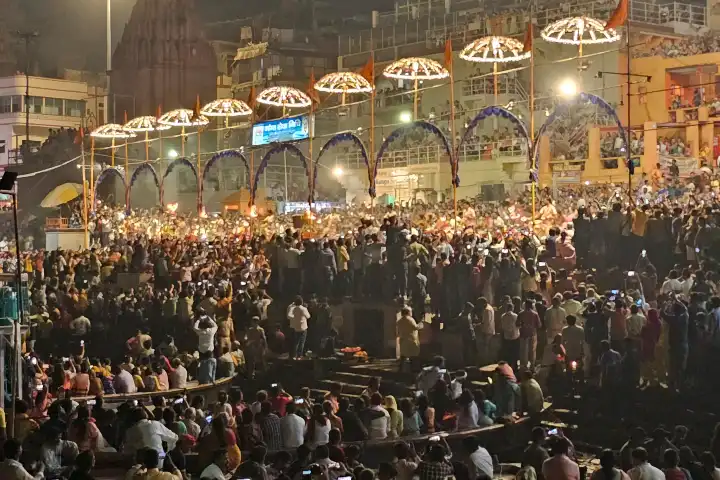VARANASI
It’s 6.30 pm at the famous Dashashwamedh Ghat in Varanasi. Tens of thousands of people have congregated—either on the ghat or on boats to see the ‘Ganga Arti’, held every day. Busy boatmen jostle to keep their vessels as close to the Ghat — for tourists to see the Arti. “There is no off season now in this town, we are busy every day,” says one of them.
Considered one of the holiest destinations for Hindus, Varanasi, which is also Prime Minister Narendra Modi’s constituency, is now getting a massive facelift. Construction and renovation work is on in full swing as the city gets ready to host a series of G20 events starting next month.
“The idea is to integrate our ancient culture with modernism..the G20 meetings will therefore be a big boost for the city’s image,” an official source said.
Logo of #G20 being illuminated at Sarnath Dhamekha Stupa in Varanasi, Uttar Pradesh.#G20India | #G20Summit | @g20org pic.twitter.com/sJWWc1GP00
— All India Radio News (@airnewsalerts) December 1, 2022
On Friday, Modi visited Varanasi– erstwhile Kashi. A slew of developmental projects including a 3.75-kilometre passenger ropeway that would connect the Varanasi Cantonment Station and the Kashi Vishwanath Corridor has been launched with an outlay of Rs 1,780 crore.
Uttar Pradesh is the ONLY state to implement SIX different Mass Urban Transport Projects simultaneously:
🚊Metro ~ Kanpur & Agra
🚊MetroLite ~ Gorakhpur
🚊Rapid Rail ~ Meerut
🚊Ropeway ~ Varanasi & Ghaziabad
🚊Pod Taxi ~ Greater Noida
🚊High Speed Rail ~ Delhi to Varanasi pic.twitter.com/0IIUWEFdmU— The Uttar Pradesh Index (@theupindex) December 8, 2021
Varanasi’s economy has boomed in the last few years, especially with the construction of the Rs 339 crore brand new Kashi Vishwanath Temple Corridor project connecting the iconic Kashi Vishwanath temple to the ghats to enable easy movement for tourists. Along with the temple and the multiple ghats, Sarnath, a popular Buddhist religious destination is also getting a makeover.
The city, noted as the seat of Hindu religion, has a mixed population. Muslims comprise about 20 per cent of the city’s population.
“All of us live in peace, there are people of various communities but there is no animosity between anyone..there are areas where people of both communities live together,” a taxi driver tells India Narrative. The city is dotted with mosques and churches as well.
In 2021, the Gyanvapi mosque controversy hit headlines. The Varanasi court in April 2021 asked the Archaeological Survey of India to conduct a survey and submit its report. The Uttar Pradesh Sunni Central Waqf Board and the Anjuman Intezamia Masjid Committee running the mosque contested the petition. “There have been some issues but with the economy booming, many are now no more interested—neither Hindus nor Muslims in these issues..economy is our religion,” he says.
The number of tourist inflow has steadily increased. In 2015 Varanasi received about 55 lakh tourists. Last year, city attracted more than 7 crore tourists—both domestic and international.
The boom in tourism has boosted the income levels of the local community. Night markets, primarily eating joints, have now opened, giving this ancient city a modern touch with global and upmarket brands and stores now donning the cityscape. “I used to earn about Rs 200 to Rs 500 a day about five to seven years ago. Today it is easily Rs 1000 a day,” a tourist guide at Sarnath reveals.
Godowlia Market At night#Travel #varanasi #viral pic.twitter.com/rwLz4dnqU0
— Traveller Kanak (@Travellerkanak) January 26, 2023
Weavers, a large number of them Muslims, who make the famous Banarasi Sarees are a happy lot too. “Today we get a better price for our weave and with so many tourists, our products get sold easily,” one of them points out.
Also Read: PM Modi anchors Varanasi as cultural hub with inauguration of novel ropeway




















